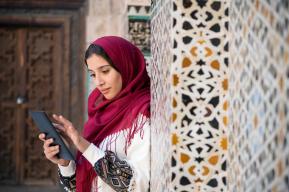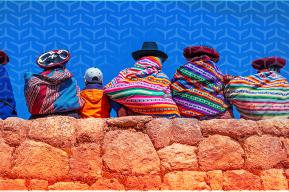فكرة
مدرسة تحت جسر في نيودلهي

أنشأ رجاش كومار شارما، منذ تسع سنوات، مدرسة خارجة عن المعتاد بين عمودين للقطار الجوّي في العاصمة الهندية. يأتي أكثر من 200 طفل فقير من الأحياء المجاورة كل يوم ليتلقوا التعليم في هذا الفصل في الهواء الطلق.
بقلم سيباستيان فارسيس، صحافي فرنسي في نيودلهي
ليس لهذه المدرسة أي أثر في أي خارطة. ليس لها جدران كاملة ولا سقف شامل، ولا حتى طاولات أو كراسي. وكما هو شأن بعض الدكاكين الصغيرة التي تُمكّن العاصمة الهندية من العيش، اندمجت الـ«فري سكول أندر ذو بريدج» (المدرسة الحرة تحت الجسر) بكل بساطة في الفضاء الحضري لنيودلهي. تسلّلت بين العمودين الضخمين رقم 5 و6 للقطار الجوي في المدينة العملاقة التي يفوق عدد سكانها عشرين مليون نسمة. وتوفر المدرسة منذ تسع سنوات التعليم مجانا لمئات الأطفال الفقراء الآتون من الأحياء القصديرية في المناطق المجاورة، على ضفاف نهر يامونا، في أرض مقفرة تقع في قلب الهند، تلك البلاد التي تزخر بالخيرات ولكنها تعاني من اكتظاظ السكّان.
الحي في لون الخرسانة، والسماء منخفضة وثقيلة كالمعتاد في موسم الأمطار. أما مدرسة الشارع، فهي تُشعّ حيويّة وألوانا. الجدران الثلاثة التي تحدّ فضاءها مطلية باللون الأزرق السماوي. غابة من الأشجار الطويلة والورود العملاقة تحيط بالسبورات السوداء الخمس المُعلّقة على الجدار الخلفي. وما أن يشاهدها التلاميذ حتى يُهرولوا من كل جهة نحو الأستاذ هاتفين «ناماستي تيتشر». هذا الرجل، محل احترام الأطفال، هو رجاش كومار شارما، 49 سنة، مؤسس «المدرسة المجانية تحت الجسر». لقد آثر على نفسه مقاومة دائرة الفقر من خلال تعليم أكثر الأطفال خصاصة.
تحد شخصي
هذا الجهاد هو أيضا تحد شخصي. لأن رجاش كومار شارما نشأ في عائلة فقيرة تعدّ تسعة أطفال من ريف أوتار برادش، في شمال البلاد، وكان دائما متعلق بالتعليم، إلا أنه لم يتمكّن من إكمال دراسته بالجامعة بسبب ضيق ذات اليد. يقول رجاش: «كانت المدرسة تبعد عن بيتنا سبع كيلومترات. وكنت أقضّي ساعة بالدراجة كي أصل إليها. عندما كنت أدرس في الثانوي، كنت دائما أتخلّف عن الحصّة الأولى، درس الكيمياء. وبما أنني لم أتحصّل على أعداد جيّدة في تلك المادّة، لم يتسنّ لي دراسة الهندسة التي كنت أحلم بها.»
ورغم ذلك تمكن من الحصول على ما يعادل البكالوريا، وهو نجاح لم يُحقّقه قبله أيّ من إخوته وأخواته الثمانية الذين يفوقونه سنّا. ثمّ تمكّن من التسجيل في الجامعة، وقد باع كتبه المدرسية للحصول على مبلغ رسوم التسجيل. وللوصول إلى الجامعة، كان عليه هذه المرّة أن يقطع 40 كيلومترا باستعمال الدراجة والحافلة. لكنه بعد سنة، قطع عنه إخوته الكبار المعونة، وتبخرت أحلامه.
منذ ذلك الحين، بدأت المرحلة الصعبة، إذ هاجر مع أخيه إلى نيودلهي، وكان عمره حوالي عشرين سنة. ويسرد ذكرياته قائلا: «كنت أبيع البطيخ، وأشتغل في حضائر البناء، وأقوم بكل ما يُمكّنني من الحصول على بعض الروبيات». وذات يوم، في حضيرة بناء المترو، أثار انتباهه وجود أبناء العمّال، الذين كانوا عموما منقطعين عن الدراسة، وهم تائهون بين الأنقاض. في البداية، كان يوزع عليهم قطعا من الحلوى وبعض الثياب، وبعد ذلك أخذ يُفكّر في مساعدة تُفيدهم على مدى أطول. وهكذا بدأ سنة 2006 في اصطحاب طفلين، تحت شجرة، لمساعدتهما على مراجعة الدروس. أحدهما، وهو يبلغ اليوم من العمر 18 سنة، دخل الجامعة مُؤخّرا، ويطمح في أن يُصبح مهندسا.
بعد أربع سنوات، في عام 2010، أنشأ مدرسته المرتجلة تحت الجسر الجوي مباشرة بعد نهاية أشغال البناء. ويستقبل حاليا 200 طفل في اليوم، من السنة الأولى من المرحلة الابتدائية إلى السنة الثالثة من التعليم الثانوي. وينقسم التلاميذ إلى مجموعتين، الأولاد في الصباح والبنات بعد الظهر، لمدّة حوالي ساعتين لكل مجموعة. أغلبهم يُزاولون تعلّمهم في أماكن أخرى ويأتون بحثا عن مساعدة دراسية. تقول مامتا، 13 سنة، في السنة الثالثة ثانوي: «يبلغ عدد التلاميذ في قسمي 63، لذلك فإنه يحدث أحيانا ألّا نفهم كل شيء، ونذهب لسيدي راجاش لاستفساره.»
فصل في الهواء الطلق
عشرات وعشرات من الأطفال الآخرين لا يزاولون تعلّمهم في أي مدرسة لأن أولياءهم مهاجرون أو يشتغلون بطرق غير نظاميّة ممّا يجعلهم غير حاملين للأوراق القانونية. لذلك يتولى رجاش كومار شارما مساعدتهم على الحصول على تلك الأوراق لتسجيلهم في المدارس. ويقوم بهذه الاجراءات مجانا بفضل المداخيل الضئيلة التي يُوفّرها له محل البقالة العائلي وبعض التبرعات المحدودة. لم يقم لحد الآن بإنشاء منظمة غير حكومية مُفسّرا: «أخشى الدخول في متاهات الوثائق، وأخاف أيضا من أن تُطردنا إدارة المترو إن هي علمت بأن المكان أصبح يحتلّه هيكل نظامي». لكن التبرّعات تُمنح له شخصيا، في غياب منظمة قانونية، وهو ما جعله يتعرض، في الفترة الأخير، إلى بعض الانتقادات. ويؤكّد المعلم: «أبذل ما في وسعي من جهد، لكنني لا أقدر على توفير الفواتير عندما أتصرّف في الأموال لاقتناء طعام الأطفال». وحتى لا تحوم حوله الشكوك، عرض عن أخذ الأموال وأصبح لا يقبل التبرعات إلى إذا كانت ملابس أو مأكولات أو كتبا.
في هذه الظهيرة الحارّة من شهر يوليو، غاب الانضباط شيئا ما في الفصل القائم في الهواء الطلق. انقسم التلاميذ، وعددهم 105، إلى مجموعات من مستويات مختلفة. ثلاثة أساتذة، كلهم مُتطوّعون، يُساعدون رجاش كومار شارما ويُشيرون بصوت عالٍ إلى حروف رُسمت على السبورة كي يُغطّي صوتُهم ضجيجَ المترو المارّ فوق رؤوسهم. يبذل المعلم ما في وسعه كي لا يفقد الأطفال التركيز. أما رجاش كومار شارما فقد انطلق في تفسير نصّ بالهندي أمام حلقة تتكوّن من خمس فتيات في انتباه تامّ. يقول هذا المُدرّس المرتجل: «نحن نستعمل الكتب المدرسية الوطنية ونعمل كل ما في وسعنا، بما أُوتينا من إمكانيات محدودة، من أجل ارتقائهم. في الماضي، كانت الدروس تُعطى في الخارج، ولذلك أظن أنه ليس من الضروري أن تكون هناك أقسام مُغلقة كي نعطي الدروس. يقال في الهند بأن أجمل الأزهار تُولد في المستنقعات.»
Sébastien Farcis
French journalist based in New Delhi
This school does not appear on any map. It does not have whole walls or a complete roof, let alone tables or chairs. Like the small street shops that keep the Indian capital alive, the “Free school under the bridge” has simply merged into New Delhi’s sprawling urban space. It nestles between the massive number five and number six pillars of the aerial metro of this megalopolis of over 20 million inhabitants. And for the past nine years, the school has provided free education to hundreds of poor children from the surrounding slums on the banks of the Yamuna River – a no-man's land located in the heart of a city that is prosperous in pockets, but badly overcrowded.
The district is a concrete grey, the sky low and heavy in the monsoon season. But the street school is full of life and colour. The three walls that make up its space are painted sky blue, with a forest of tall trees and giant roses surrounding the five blackboards that hang on the back wall. As soon as they spot him, the students run up to the teacher from everywhere, shouting “Namasté, teacher!” The man held in such esteem by the children is Rajesh Kumar Sharma, 49, founder of the “Free school under the bridge”. He considers it his mission to help break the cycle of poverty by improving the education of the poorest.
Personal vindication
His battle is also a personal vindication. Sharma, who comes from a poor family of nine children in a rural area of Uttar Pradesh state in the country’s north, had always wanted to study but could not finish university because he lacked the means. “The school was seven kilometres from my home,” he says. “It took me over an hour to cycle there. When I was in high school, I always missed chemistry, which was the first class. As a result, I didn’t get good marks in this subject, and couldn’t go on to study engineering, which was my dream.”
Sharma still managed to obtain a high school degree, a feat that none of his eight older brothers and sisters had achieved. He enrolled in university, selling his textbooks to pay the registration fees. To get there, he had to travel more than forty kilometres by bicycle and bus. But after a year, the elders in his family cut off the funds for his education. His dream was cut short.
The next phase in Sharma’s life was challenging. When he was about 20, he moved to New Delhi with his brother. “I sold watermelons, worked on construction sites, did anything I could to earn a few rupees,” he recalls. One day, on the metro construction site, he was shocked to see the workers’ children, most of them out of school, wandering amidst the rubble. At first he offered them candy and clothes, and then he considered providing them more sustainable help. And thus, in 2006, he began helping two children with their homework, under a tree. One of them, now 18, has just entered university, and wants to become an engineer.
Four years later, in 2010, he set up his makeshift school under the newly-built aerial bridge, where he now welcomes more than 200 children a day – at levels ranging from the first year of primary to the third year of secondary school. The students are divided into two groups – boys in the morning, and girls in the afternoon, for almost two hours each. Most of them also attend the local school, but come to him for academic support. “We have sixty-three students in my class,” says Mamta, 13, who attends the third year of high school. “Sometimes we can't understand everything, so we come and ask Mr Rajesh.”
Outdoor classes
There are many other children who do not attend school because their parents – migrants or informal workers – are undocumented. Sharma helps them to get papers, so they can enroll their children in school. He does this for free, relying on the meagre income from his family grocery store and occasional donations. So far, he has refused to create a non-governmental organization (NGO). “It’s a way to avoid paperwork, but also because I'm afraid that with a formal structure, the metro authorities will be afraid that we’ve settled in, and will kick us off their property,” he explains. But in the absence of a legal organization, donations are received in his personal name, which has recently exposed him to criticism. “I do the best I can, but I can't provide an invoice when I use the donated money to feed the children,” he says. To dispel such doubts, he has stopped accepting money and only receives donations of clothing, food and books.
On this hot July afternoon, the outdoor classroom is a little disorganized. The 105 students are divided into groups of different levels. Three teachers, all volunteers, assist Sharma and have to shout as they point to the letters on the board, to be heard above the noise of the metro overhead. One teacher does his best to hold the attention of the youngest pupils. Sharma, meanwhile, is busy interpreting a Hindi text to a circle of five very attentive girls. “We use the national textbooks and do everything we can with the few resources we have, to help them progress,” explains this improvisational teacher. “In the old days, classes were held outdoors, so I don't think it’s essential to have closed classrooms to teach properly. In India, it is said that the most beautiful lotuses are born in the marshes.”







